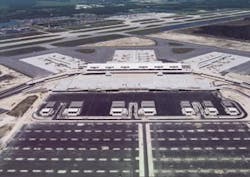In the first week of October 2004 Southwest Florida International Airport (RSW), operated by the Lee County Port Authority, launched wireless fidelity (WiFi) throughout the terminal to provide free Internet access to its passengers.
It was a challenge to enter into a WiFi project of this magnitude, knowing the current terminal would be demolished in less than a year. The majority of wireless networks required a wired infrastructure to support access points located roughly 300 feet apart. Less than one-third of the terminal had Port Authority infrastructure available.
Reluctantly, the airport contacted with different service providers for suggestions and quotes. The suggestions came in accompanied by references where WiFi was working in hot spots all over the country.
Meanwhile, it was recognized that Southwest Florida International could not spend $70,000 to $80,000 on infrastructure to fill wired network gaps to meet the WiFi access point density required to support passengers.
Cooperative Installation
Airport administration decided to test a unique concept in wireless presented to them by Patrick J. Teague of TEACO, Inc., who suggested RSW use two BelAir 200 outside antennas (inside the terminal) to cover its two 770-foot concourses that were void of network cabling, and three iNET catcher wireless access points to cover two concourse annex areas and the center mezzanine area.
The airport entered into a cooperative installation in which TEACO would supply the hardware and technical expertise, and the Port Authority would provide a link from the BelAir and iNET catcher access points to our network. The cost for this experiment was very modest and an easy sell to management for two reasons:
• We could transfer the equipment to our new terminal; and
• The installation would be done in three days without disrupting our passengers.
The system worked well beyond expectations, but there was a nagging concern. The airport had approved installing a very robust, easy to use WiFi that could be accessed by passengers anywhere in the terminal. What about hackers? Would the security built in by iNET catcher protect the airport?
System Security
After the system had been in operation for a while, a local TV station reporter wanted to interview me live and discuss the WiFi free service. I agreed to the interview and stood in front of the camera when the talent introduced two “hackers” that had spent two days moving around the public area, hacking away at the WiFi network.
The reporter asked: “Do you feel you have any responsibility for informing the public that a hacker could access the sensitive information on their laptops when they are enticed by you to use the airport’s free WiFi? Our team was able to access 17 laptops while they were here.”
The smile on my face embarrassed me later that night when I saw the rerun of the interview. The hackers could not see the Port Authority network, they thought it was a direct dual T-1 access to the Internet.
An Airline Takes the Plunge
The station manager of USA 3000 saw the broadcast and asked if the airport could help the airline. The carrier didn’t want to invest in a wired network for a lifespan of less than a year and requested permission to use our wireless network. An agreement was reached and the airport placed a spare access point in the old International Terminal’s meeters and greeters waiting room, a temporary location that would be used by USA 3000 until the new terminal is completed.
The network has been operating with few problems. Lightning hits that caused surges and power failures caught us by surprise, but other then a few times since October the network has had no problems. USA 3000 had been quietly processing passengers via our wireless link, off in its corner — out of sight, out of mind.
Wireless Meets Other Challenges
The airport then turned its attention to a different challenge: the need to issue over 3,500 new ID cards for security access in the new terminal. The security server was located in the new terminal; the thought of transporting this huge number of people to a terminal under construction would be very costly and time-consuming. When RSW examined the liability issues of placing non-construction people in a building under construction the security staff began having stress.
A call to TEACO was made and a solution was developed.
Install three BelAir antennas, two on the new terminal and one on the fire station to create a redundant WiFi link between the security telecom communications room and the ID Office. Again, in a matter of days the airport was able to begin issuing ID cards from the server two miles away via a wireless link.
Wireless has been thought of to do exactly what RSW has experienced. Passengers are happy, staff is happy because they can use the wireless link to perform critical tasks, and the IT staff is happy because it required very little effort to install and maintain the wireless network.
In a staff meeting, the airport’s finance director discussed airline activity saying, “USA 3000 is a surprise; they did a little over 16,000 passengers in June of 2004 and this June they boarded 42,719. Fiscal year to date (October to the end of June) they processed 400,971 passengers.”
If we had charged the airline 25 cents per passenger, USA 3000 would have paid us $100,242.75.
Not bad for a $20,000 initial investment. The airport’s return on investment with just one airline using the system would have been two months.
WiFi in our airports deserves a closer look — it provides flexibility. Southwest Florida International was able to install the system in days, while a wired solution would have taken weeks. And, the airport is not limited to frequencies, our solution could use all eleven channels.
The revenue from passengers using WiFi does not approach the revenue we would have received from USA 3000, had the airline been charged for the service.





